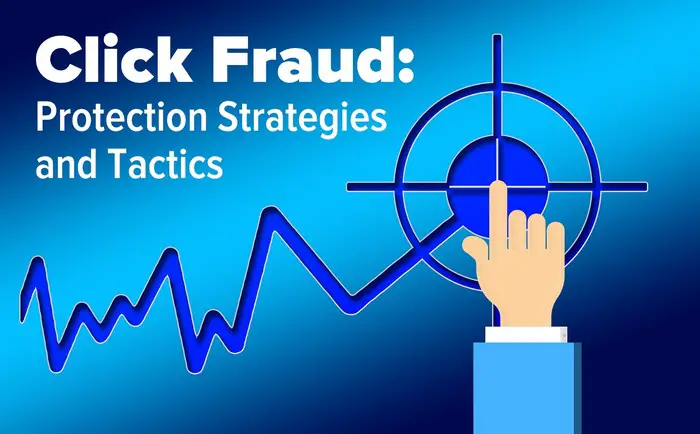In this new article, we are talking about click fraud protection, offering you some useful strategies and tactics to help you with click fraud prevention.
We will be covering
- Click Fraud: Types, Tactics, and Methods
- Click Fraud Examples
- Bots, Manual Clicks, and the Era of Automated Fraud
And a whole lot more.
Let’s get started.

Click Fraud Protection Strategies And Tactics
Pay-per-click (PPC) marketing has been one of the main forms of digital advertising ever since Google ads got its start back in 2000.
Since those early days, the PPC industry has grown into a multi-billion-dollar industry of its own and has branched out from Google Ads to other platforms as well (e.g. social media).
PPC campaigns work very well at increasing traffic and garnering conversions, which is why they remain as one of the most widely used advertising methods on the web.
Nearly all businesses have a digital marketing strategy nowadays (especially since internet use has become so widespread throughout the world).
People are spending over 15 hours of their free time each week browsing the web.
This means that the internet is where everyone’s attention is focused (including marketers, advertisers – and yes, fraudsters).
PPC marketing is popular, so much so that there is an entire underground industry dedicated to committing click fraud.
What is click fraud you might ask?
Don’t worry – below is a complete overview of click fraud.
We cover exactly what it is, how to defend against it, as well as some of the common tactics fraudsters use to commit fraud against PPC advertisers.
Click Fraud: Types, Tactics, And Methods
In the most simple terms possible; click fraud is when a person (or bot) artificially inflates the number of clicks on an advertisement.
The purpose behind committing click fraud is either draining the advertising budget of the company paying for the ad, or inflating the number of clicks on a publisher’s site (to make money off of the ad).
Either way, the advertiser is the one paying the final price here (which is why click fraud is such a hot topic among digital marketers – especially those operating in the PPC space).
Luckily, there are several ways to defend against click fraud activities (most of which we cover in the next section).
Join the conversation - In this new article, we are talking about click fraud protection, offering you some useful strategies and tactics to help you with click fraud prevention. Click To TweetClick Fraud Types And Examples
The first type of click fraud that we’ll cover is that of publisher-based ad fraud.
As the title implies, this type of fraud is committed by website publishers looking to artificially increase the number of clicks the ads on their sites receive.
Their reasoning behind doing this is simple: money.
More clicks equal more money for the publisher (paid through the ad network – which oftentimes happens to be Google).
This type of fraud can be devastating to advertisers (you know, the ones who are paying for every single one of those fake clicks).
Not only can this type of fraud quickly deplete an advertiser’s budget, but it can also drive up the cost of any future ads they want to run.
Another very common type of click fraud revolves around the fraudster attempting to drain the ad budget of a competing company.
An example of a common scenario found throughout the PPC industry is highlighted below:
Let’s say company B is routinely showing up lower in the paid SERPs (search engine result pages) than company A.
Company B then decides to hire a fraudster to artificially inflate the number of clicks that company A is getting.
Doing this allows company B to quickly drain company A’s ad budget (allowing them to swoop in and outbid them for the top spot in the paid search results).
While the two tactics mentioned above are the most common ones, there’s also one more.
This type of fraud is known as “CTR fraud.”
The click-through rate of a result in the SERPs is known to increase that URLs ranking.
The purpose of artificially clicking on a URL in the SERPs is to increase that URL’s organic result for a specific keyword.
While this doesn’t directly affect advertisers, it can still have negative consequences on your brand’s PPC campaigns (especially if this type of fraud is committed by a competing company).
If you’ve been a victim of click fraud in the past (or currently are a victim), you should look into hiring an anti-click fraud service provider.
For example, with Clickcease (one of the web’s preeminent click fraud detection services), you can easily detect (and defend) against common click fraud attacks.
Bots, Manual Clicks, And The Era Of Automated Fraud
Generally speaking, there are two ways that click fraud can occur; manually (i.e. a human being doing the clicking) or via bots (i.e. automation software).
Click fraud activities in 2020 are mostly done via sophisticated bot networks.
Back in the early days of click fraud, bots were relatively simple creations.
All they needed to do was to click a link/button (because there were very few anti-fraud strategies being employed in those days).
Fast forward to 2020 though, and most major ad networks have some type of anti-fraud department.
This means that click fraudsters have needed to become much, much more sophisticated than their forefathers of the early 2000s.
The majority of click fraud bots are programmed to behave as realistically (read: human) as possible.
These bots don’t simply just click a button/link, but they perform many of the same behaviors that a human might (e.g. scrolling, clicking other links, etc.).
The purpose of programming a bot to behave like a human is to hide the bot’s real activity under a cloak of behavior that looks as authentic as possible (making it much more difficult for webmasters and anti-fraud programs to catch)
Advanced Botting And Click Fraud
Click fraud bots have evolved quite a bit since the early days of PPC.
Not only can they mimic human interactions (in regards to website usage), but fraudsters have figured out how to create massive botnets (solely for the purpose of click fraud).
What is a botnet?
This term is used to describe when a remote attacker gains access to numerous machines (for exploitation purposes).
In terms of click fraud, a botnet means that the fraudster can control a countless number of machines remotely, to generate fake clicks.
The purpose of creating a botnet, and using it for click fraud, is to hide the malicious activity across numerous “users.” Webmasters (and anti-fraud companies) are always carefully reviewing website analytics data for signs of click fraud.
Using a botnet is one of the best ways to shield fraudulent activities (e.g. by using a botnet a fraudster can generate clicks across numerous IP addresses – not just one, as is commonly seen in lower-level attacks).
We’re not talking about hundreds of machines here either.
No, botnets usually infect tens of thousands of machines (or even millions).
Remember, the PPC industry is worth tens of billions of dollars.
Do you really think that this large amount of money being thrown around doesn’t attract lesser elements?
Click fraud botnets usually infect a user’s machine via malware.
Most users don’t even realize that their machines are being used for fraudulent purposes (which makes it that much more difficult for the fraudsters to be caught).
- Note: There have been many different click fraud botnets detected and defeated, most of them have infected hundreds of thousands of machines throughout their deployment.
The Human Side of Click Fraud
Not all click fraud activities originate from botnets or automated software.
Sometimes fraudsters actually hire people to work as “clickers.”
Workers employed on these click farms typically come from areas of the world where there aren’t many opportunities (i.e. developing countries).
These workers are used to artificially inflate the stats on publisher websites.
They can also be used to force competitors to pay higher prices for their ads (or also be used to deplete their ad budgets).
Ever since social media has taken the world by storm, these workers are also used to like, comment, and interact with social media pages as well.
In fact, there is a huge economy around fake social media interactions (e.g. fake likes, comments, subscribers, followers, etc).
Oftentimes these click farms are multipurpose in their structure.
Most fraudsters would actually like to use a click farm over a botnet.
The reasoning behind this is relatively straightforward: humans clicking on a website will always be more natural than bots doing the same interactions.
Click farms are notoriously hard to detect (especially if they’re operated by someone with some technical prowess).
The negative aspect of click farms (from the fraudster’s point of view), is that they’re much more costly to operate than a botnet (and also present certain logistical challenges which aren’t an issue with botnets).
So, while most fraudsters would probably prefer the results that a click farm can generate, most of them prefer botting for its practicality.
Most decent anti-fraud departments and/or fraud detection software services use specialized tools to detect (and protect) against botnet click fraud.
Automated click fraud isn’t going anywhere anytime soon, and choosing a company that places an emphasis on bot protection would be a wise choice for your business.
How Click Fraud Can Destroy Websites
Ask any web manager what they hate the most about bots, and their answer will undoubtedly include the fact that they (bots) severely screw up a website’s analytics. While natural traffic spikes do occur from time to time, the unreal amount of traffic exhibited by bots affects everything from a site’s CTR, bounce rate, etc. which can translate to a lot of headaches (for web managers).
The other way that click fraud can affect a website is by causing major problems on the back-end.
If a botnet that’s 200,000 machines strong attacks your website, your actual customers/users are going to be the ones suffering.
So, what’s the best way for your business to protect its website (and its customers/users) from the effects of click fraud bots?
Hiring an anti-fraud company to manage the detection/protection side of things (while you focus on what’s important – i.e. running your business), is the optimal choice for most brands (especially those with a heavy internet focus).

The Future Of Click Fraud Protection and Anti-Fraud Services
The end of this past decade saw some major changes come to pass.
The internet is no longer the arena of nerds and power users.
No, nowadays everyone from grandmothers to your boss uses the internet for all sorts of activities (e.g. working, watching TV, reading, etc.).
While most people used to browse the internet from desktop computers, nowadays nearly everything is done from a mobile device (whether that’s a smartphone or a tablet).
Desktop and laptop browsing habits are on the decline.
So what does this mean in regards to click fraud?
With the shift to mobile in full swing, mobile-based click fraud is rapidly rising.
If your business operates any sort of mobile application, you need to start focusing on mobile click fraud detection and protection strategies.
This also applies to mobile websites as well.
Pretty much all websites are responsive (or at least they should be).
This is great for optimal UX and UI (considering that everyone uses the internet from their mobile devices), however, it leaves a huge vulnerability in regards to mobile click fraud.
Mobile fraud detection is still a relatively new area of the anti-fraud industry, and it will continue to grow in its overall importance over the next few years.
One of the more exciting developments in the anti-fraud industry is the developing correlation between impressions and clicks, and how some companies are using that correlation to create specialized detection software.
Unfortunately, click fraud isn’t going anywhere anytime soon.
There is far too much monetary incentive for fraudsters to ever stop trying to swindle advertisers and ad networks.
However, there are a variety of methods that can be employed in the fight against fraud.
The number one thing that any business should consider when it comes to click fraud protection, prevention is contracting out its anti-fraud strategy to a firm that specializes in click fraud.
Constantly evaluating and reviewing analytics can be a full-time job in and of itself, which is why most brands prefer to hire a click fraud detection company to manage their anti-fraud activities.
That’s all for now.
So do you employ any click fraud protection strategies when running your ad campaigns or is click fraud prevention still on your to-do list?
Let us know in the comments section below.
Regards Dexter
Related Articles
Security Stats You Should Know – Insider Threat Detection for 2020
Cybersecurity Risk – What’s your strategy for Cybersecurity?












Lily Howard (IN LIKE)
Hi Dexter, Nice to meet you 🙂
Here are more tips on click fraud protection. I know this is important for every viewer. Now let’s see what the strategies are. We are now in 2020, and at this time we have much to know. So, I suggest you read this article. Then cleck safely of any kind. Have a great day!!! Happy 2020:)
Lily Howard (IN LIKE) recently posted…Come here for your likes!
Poscart
Hi, this is such a great article.
Think you just about covered everything on blog commenting,
I’ll bookmark your site and come back to read your
other articles!
Dexter Roona
Thank you!
Dexter Roona recently posted…How to find orphaned content quickly
Shane McEvoy
Great post Dexter and a problem which has cost some businesses a small fortune in Ad spend. Luckily there are tools which specialise in anti-click fraud so might be worth a look at for anyone running a ppc campaign with a decent budget.
Dexter Roona
Hi Shane, thanks for stopping by.
I have another article that might interest you.
https://infobunny.com/what-is-gener8/
Interested to know what you think about this.
Regards Dexter
Dexter Roona recently posted…Internal linking strategies for SEO